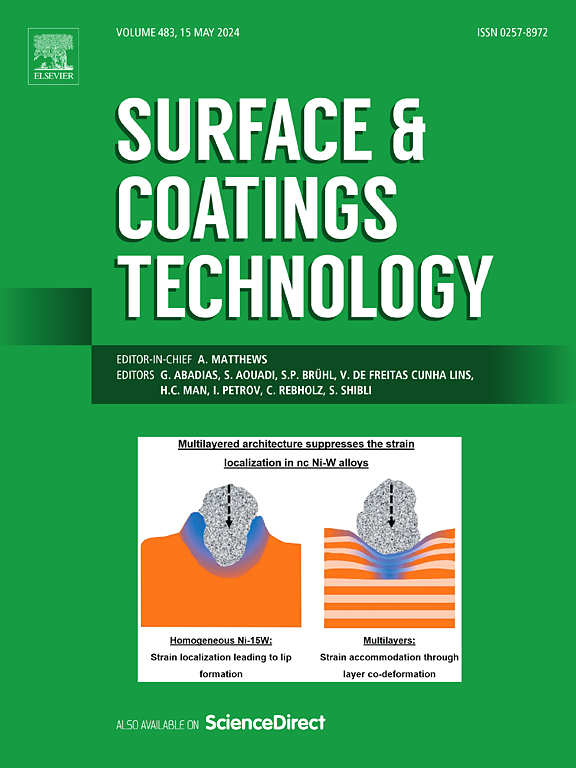用于持久油水分离的自修复超亲水性聚脲复合涂层
IF 6.1
2区 材料科学
Q1 MATERIALS SCIENCE, COATINGS & FILMS
引用次数: 0
摘要
油水分离膜容易受到环境的破坏,限制了油水分离膜在含油废水处理中的应用。提高这些膜的耐久性仍然具有挑战性。在这项研究中,我们将坚固的聚脲(PU)加入涂层中。通过调整聚脲的结构,引入多个氢键和动态二硫键,使聚脲涂层在80℃下具有90.53%的自愈效率。二硫键使涂层具有自愈特性,而多个氢键增强了涂层的稳定性。天然产物植酸(PA)和正电子化合物聚乙烯亚胺(PEI)通过氢键、配位螯合和静电相互作用与聚脲涂层协同作用,增强了聚脲涂层的亲水性。在不锈钢网表面涂覆复合涂层,得到PEI/PA/SHPU@SSM。经过32次油水分离循环后,自愈组的分离效率保持在97.6%,比非自愈组高出1.3%。经过30次磨损循环后,自愈组水下油接触角为147.1°,比非自愈组高6.5°。研究结果表明,自愈对提高PEI/PA/SHPU@SSM的油水分离耐久性具有重要作用。该研究为提高超亲水性涂层材料的耐久性提供了新的思路。本文章由计算机程序翻译,如有差异,请以英文原文为准。

Self-healing superhydrophilic polyurea composite coating for durable oil/water separation
Oil/water separation membranes are prone to damage from environment, which limits their application in treating oily wastewater. Improving the durability of these membranes remains challenging. In this study, we incorporated robust polyurea (PU) into a coating. The structure of polyurea was modulated to introduce multiple hydrogen bonds and dynamic disulfide bonds, thus affording a polyurea coating with 90.53 % self-healing efficiency at 80 °C. The disulfide bonds imparted self-healing properties to the coating, while the multiple hydrogen bonds enhanced its stability. Phytic acid (PA), a natural product, and polyethyleneimine (PEI), a positronic compound, were synergistically combined with the polyurea coating to increased hydrophilicity through hydrogen bonding, coordination chelation, and electrostatic interactions. PEI/PA/SHPU@SSM was obtained by applying the composite coating to a stainless steel mesh surface. After 32 oil/water separation cycles, the self-healing group maintained a separation efficiency of 97.6 %, outperforming the non-self-healing group by 1.3 %. After 30 abrasion cycles, the underwater oil contact angle of the self-healing group was 147.1°, which was 6.5° higher than that of the non-self-healing group. The results highlight the effectiveness of the self-healing in enhancing the oil/water separation durability of PEI/PA/SHPU@SSM. This study offers new insights for improving the durability of superhydrophilic coating materials.
求助全文
通过发布文献求助,成功后即可免费获取论文全文。
去求助
来源期刊

Surface & Coatings Technology
工程技术-材料科学:膜
CiteScore
10.00
自引率
11.10%
发文量
921
审稿时长
19 days
期刊介绍:
Surface and Coatings Technology is an international archival journal publishing scientific papers on significant developments in surface and interface engineering to modify and improve the surface properties of materials for protection in demanding contact conditions or aggressive environments, or for enhanced functional performance. Contributions range from original scientific articles concerned with fundamental and applied aspects of research or direct applications of metallic, inorganic, organic and composite coatings, to invited reviews of current technology in specific areas. Papers submitted to this journal are expected to be in line with the following aspects in processes, and properties/performance:
A. Processes: Physical and chemical vapour deposition techniques, thermal and plasma spraying, surface modification by directed energy techniques such as ion, electron and laser beams, thermo-chemical treatment, wet chemical and electrochemical processes such as plating, sol-gel coating, anodization, plasma electrolytic oxidation, etc., but excluding painting.
B. Properties/performance: friction performance, wear resistance (e.g., abrasion, erosion, fretting, etc), corrosion and oxidation resistance, thermal protection, diffusion resistance, hydrophilicity/hydrophobicity, and properties relevant to smart materials behaviour and enhanced multifunctional performance for environmental, energy and medical applications, but excluding device aspects.
 求助内容:
求助内容: 应助结果提醒方式:
应助结果提醒方式:


